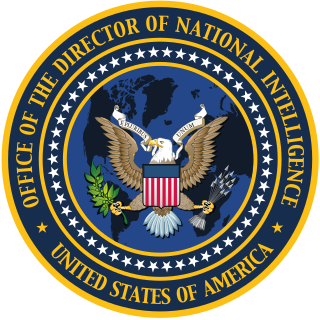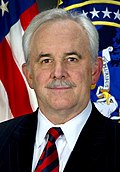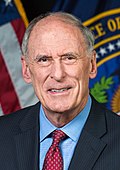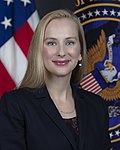Top Qs
Timeline
Chat
Perspective
Director of National Intelligence
US Cabinet-level government official From Wikipedia, the free encyclopedia
Remove ads
The director of national intelligence (DNI) is a cabinet-level United States government intelligence and security official. The position is required by the Intelligence Reform and Terrorism Prevention Act of 2004 to serve as executive head of the United States Intelligence Community (IC) and to direct and oversee the National Intelligence Program (NIP). All 18 IC agencies, including the Central Intelligence Agency (CIA), the Defense Intelligence Agency (DIA) and the National Security Agency (NSA), report directly to the DNI. Other federal agencies with intelligence capabilities also report to the DNI, including the Federal Bureau of Investigation (FBI).
The DNI also serves as the principal advisor to the president of the United States, the National Security Council, and the Homeland Security Council on all intelligence matters. The DNI, supported by the Office of the Director of National Intelligence (ODNI), produces the President's Daily Brief, a classified document including intelligence from all IC agencies, handed each morning to the president of the United States.[1] The DNI, who is appointed by the president of the United States and is subject to confirmation by the United States Senate, serves at the pleasure of the president.
President George W. Bush strengthened the role of the DNI on July 30, 2008, with Executive Order 13470,[2] which, among other things, solidified the DNI's legal authority to direct intelligence gathering and analysis, and to set policy for intelligence sharing with foreign agencies and for the hiring and firing of senior intelligence officials.[3] The DNI was given further responsibility for the entire IC's whistleblowing and source protection by President Barack Obama via Presidential Policy Directive 19 on October 10, 2012.
The position was elevated to a cabinet-level role during the first presidency of Donald Trump and retained this status under President Joe Biden. Currently, the DNI attends all cabinet meetings and liaises with the executive office of the president and other Cabinet secretaries in the execution of their duties. Donald Trump nominated Tulsi Gabbard to the position in 2025 and she was subsequently confirmed by the US Senate.[4][5]
Remove ads
History
Summarize
Perspective
Founding
Before the DNI was formally established, the head of the United States Intelligence Community was the director of central intelligence (DCI), who concurrently served as the director of the Central Intelligence Agency (CIA).
The 9/11 Commission recommended establishing the DNI position in its 9/11 Commission Report, not released until July 22, 2004, as it had identified major intelligence failures that called into question how well the intelligence community was able to protect U.S. interests against foreign terrorist attacks.
Senators Dianne Feinstein, Jay Rockefeller and Bob Graham introduced S. 2645 on June 19, 2002, to create the position of Director of National Intelligence. Other similar legislation soon followed. After considerable debate on the scope of the DNI's powers and authorities, the United States Congress passed the Intelligence Reform and Terrorism Prevention Act of 2004 by votes of 336–75 in the House of Representatives, and 89–2 in the Senate. President George Bush signed the bill into law on December 17, 2004. Among other things, the law established the DNI position as the designated leader of the United States Intelligence Community and prohibited the DNI from serving as the CIA director or the head of any other intelligence community element at the same time. In addition, the law required the CIA Director to report their agency's activities to the DNI.
Critics say compromises during the bill's crafting led to the establishment of a DNI whose powers are too weak to adequately lead, manage and improve the performance of the intelligence community.[6] In particular, the law left the United States Department of Defense in charge of the National Security Agency (NSA), the National Reconnaissance Office (NRO), and the National Geospatial-Intelligence Agency (NGA).
Under 50 U.S.C. § 3026, "under ordinary circumstances, it is desirable" that either the director or the principal deputy director of national intelligence be an active-duty commissioned officer in the armed forces or have training or experience in military intelligence activities and requirements. Only one of the two positions can be held by a military officer at any given time. The statute does not specify what rank the commissioned officer will hold during their tenure in either position.
Appointments
The first director of national intelligence was former U.S. ambassador to Iraq John Negroponte who was appointed on February 17, 2005, by President George W. Bush, subject to confirmation by the U.S. Senate. It was reported that President Bush's first choice for DNI was former director of central intelligence Robert M. Gates, who was serving as president of Texas A&M University, but who declined the offer.[7] Negroponte was confirmed by a Senate vote of 98–2 on April 21, 2005, and he was sworn in by President Bush the same day.
On February 13, 2007, Mike McConnell became the second director of national intelligence, after Negroponte was appointed Deputy Secretary of State. Donald M. Kerr was confirmed by the U.S. Senate to be Principal Deputy Director of National Intelligence on October 4, 2007, and sworn in on October 9, 2007. Kerr, from Virginia, was previously the director of the National Reconnaissance Office and the deputy director for science and technology at the CIA before that. Earlier in his career, he was an assistant director at the FBI, in charge of their Laboratory Division from 1997 to 2001.
On January 29, 2009, retired Navy admiral Dennis C. Blair became the third DNI on after being nominated by newly inaugurated President Barack Obama.[8] President Obama dismissed Blair whose resignation became effective May 28, 2010.[9]
On July 20, 2010, President Barack Obama nominated retired Air Force lieutenant general James Clapper as the fourth DNI. Clapper was confirmed by the U.S. Senate on August 5, and replaced acting director David C. Gompert.
The fifth DNI, Dan Coats, the sixth DNI, John Ratcliffe, and acting DNIs Joseph Maguire, Richard Grenell and Lora Shiao, all served between March 16, 2017, and January 21, 2021, during the first administration of President Donald Trump.
The seventh DNI is Avril Haines, who took office on January 21, 2021. The first woman to hold the office, she was nominated by President-elect Joe Biden on November 23, 2020[10] and confirmed by the Senate on January 20, 2021.[11] She resigned January 20, 2025 at the conclusion of Joe Biden's term in office.
On November 13, 2024, President-elect Donald Trump announced his intention to nominate Army Reserve lieutenant colonel Tulsi Gabbard as the director of national intelligence upon returning to the presidency in January 2025. Gabbard was confirmed by the U.S. Senate on February 12, 2025, replacing acting director Lora Shiao.
Website issues
Declan McCullagh at News.com wrote on August 24, 2007, that the DNI site was configured to repel all search engines to index any page at DNI.gov. This effectively made the DNI website invisible to all search engines and in turn, any search queries.[12] Ross Feinstein, Spokesman for the DNI, said that the cloaking was removed as of September 3, 2007. "We're not even sure how (the robots.txt file) got there" – but it was again somehow hidden the next day. On September 7, McCullagh reported that the DNI appeared to be open to web searches again.[13]
Reform initiatives
In September 2007, the Office of the DNI released "Intelligence Community 100 Day & 500 Day Plans for Integration & Collaboration". These plans include a series of initiatives designed to build the foundation for increased cooperation and reform of the U.S. Intelligence Community.[14]
Remove ads
Office of the Director of National Intelligence
Summarize
Perspective
The Intelligence Reform and Terrorism Prevention Act of 2004 established the Office of the Director of National Intelligence (ODNI) as an independent agency to assist the DNI. The ODNI's goal is to effectively integrate foreign, military and domestic intelligence in defense of the homeland and of United States interests abroad.[15] The ODNI has about 1,750 employees.[16] Its headquarters are in McLean, Virginia.
On March 23, 2007, DNI Mike McConnell announced organizational changes, which included:
- Elevating Acquisition to a new Deputy DNI position
- Creating a new Deputy DNI for Policy, Plans, and Requirements (replacing the Deputy DNI for Requirements position)
- Establishing an Executive Committee
- Designating the Chief of Staff position as the new Director of the Intelligence Staff
The ODNI continued to evolve under succeeding directors, culminating in an organization focused on intelligence integration across the community.[citation needed]
Organization
The ODNI leadership includes the director, principal deputy director and chief operating officer.[17] In addition, the Director of Defense Intelligence reports to the DNI.
There are two directorates, each led by a deputy director of National Intelligence:[17][18]
- Mission Integration Directorate
- Policy & Capabilities Directorate
There are five mission centers, each led by a director of that center:[17][18]
- National Counterproliferation and Biosecurity Center
- National Counterterrorism Center
- National Counterintelligence and Security Center
- Foreign Malign Influence Center
- Cyber Threat Intelligence Integration Center
There are also four oversight offices:[17][18]
- Office of Civil Liberties, Privacy and Transparency (CLPT), led by the Civil Liberties Protection Officer (CLPO)[19]
- Office of Equal Employment Opportunity & Diversity
- Office of the Intelligence Community Inspector General
- Office of General Counsel
Organization seals
United States Intelligence Community
Remove ads
Directors
Summarize
Perspective
Position succeeded the Director of Central Intelligence.
Denotes acting capacity. |
Line of succession
The line of succession for the director of national intelligence is as follows:[20]
- Principal Deputy Director of National Intelligence
- Deputy Director of National Intelligence for Intelligence Integration
- Director of the National Counterterrorism Center
- Director of the National Counterintelligence and Security Center
- Inspector General of the Intelligence Community
Subordinates
Principal Deputy Director of National Intelligence
Chief Operating Officer
Director of the Intelligence Staff/ Chief Management Officer
Inspector General of the Intelligence Community
Deputy directors of national intelligence
Assistant directors of national intelligence
Remove ads
See also
- Information Sharing Environment
- Intelligence Advanced Research Projects Activity
- Intellipedia
- Joint Worldwide Intelligence Communications System (JWICS)
- National Intelligence Coordination Center
- The National Security Act of 1947
- Open source intelligence
- Title 32 of the CFR
- United States Joint Intelligence Community Council
- US intelligence community A-Space
- Privacy and Civil Liberties Oversight Board (PCLOB)
Remove ads
References
Further reading
External links
Wikiwand - on
Seamless Wikipedia browsing. On steroids.
Remove ads
























